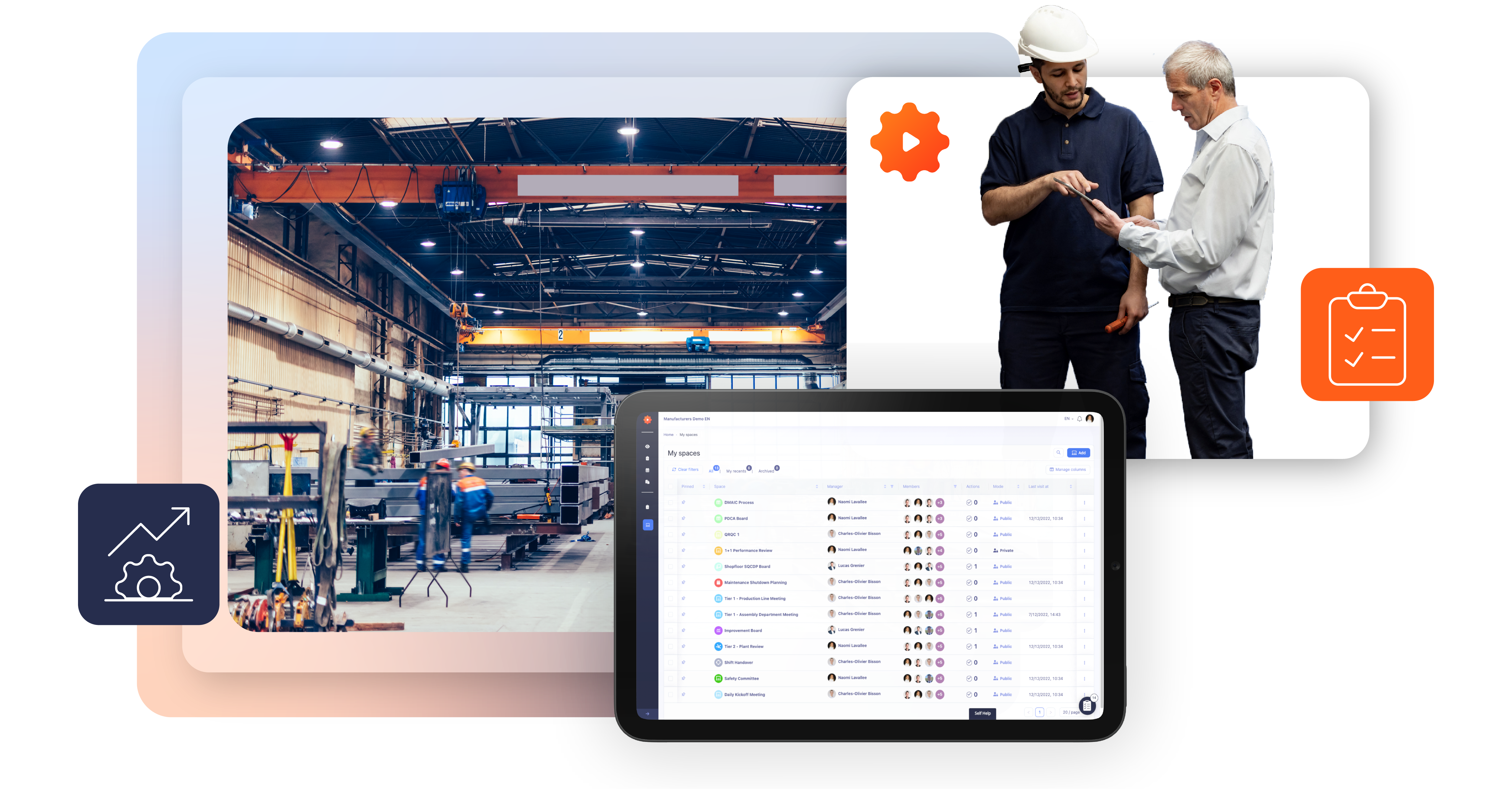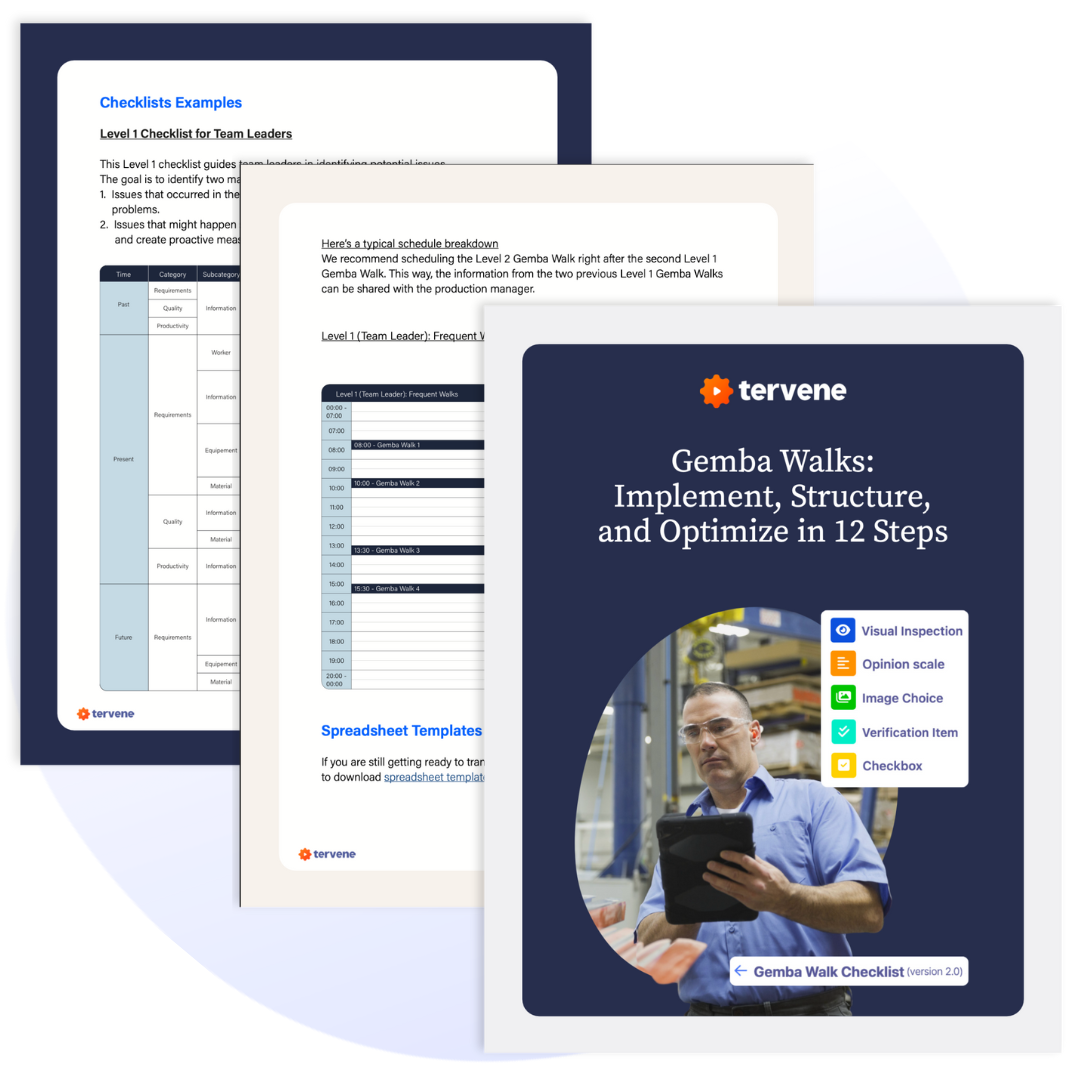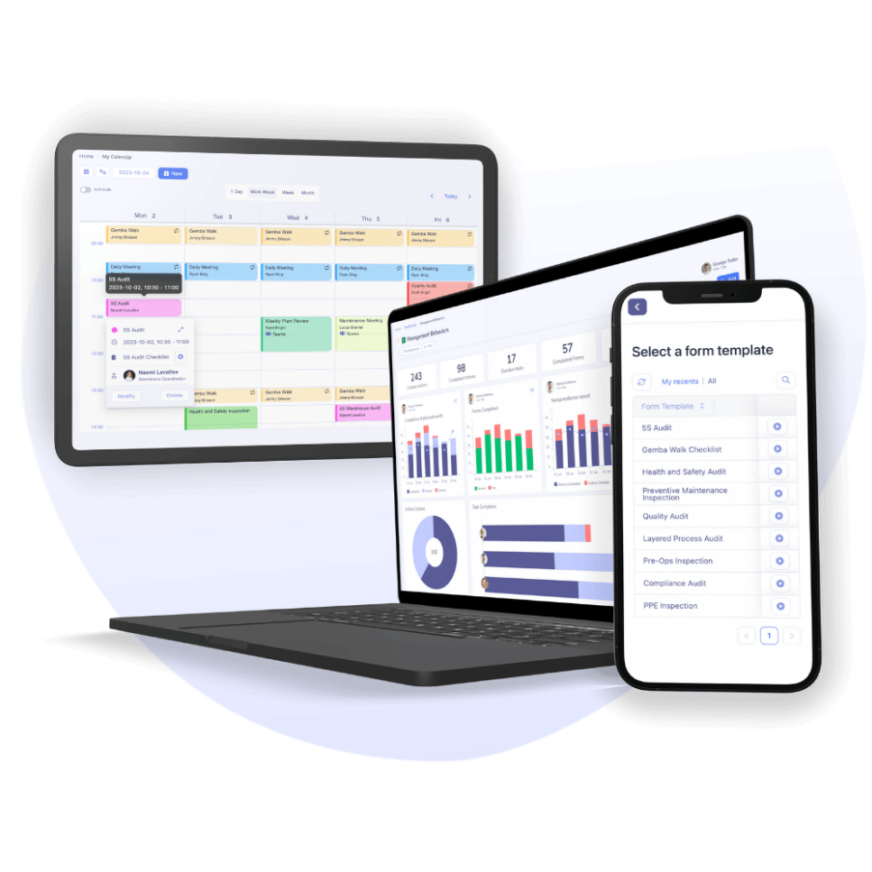Daily Management System (DMS): From Basics to Launch

| Audience: | Manufacturing Managers, Healthcare Administrators, Operational Excellence and Lean Management Practitioners, HR Coordinators, Organizational Leaders |
| Last updated: | August 22, 2025 |
| Read time: | 8 mins |
- This system isn’t static. It constantly seeks improvement by monitoring performance and identifying areas for tweaks.
- Leader walks and performance checks become a safety net. Problems get spotted and addressed quickly before they snowball.
- Communication is vital in DMS. Everyone, from top to bottom, is encouraged to share ideas and work together for success.
What Is a Daily Management System (DMS)?
A Daily Management System, commonly referred to as a DMS, is the structure by which organizations conduct operational management to ensure their day-to-day operations go as planned and continuously improve. In other words, it encompasses all operational control and continuous improvement activities from the factory floor to the highest management levels.
In a typical context, supervisors perform regular Gemba Walks to ensure ongoing control over factors such as productivity, quality, health & safety, and other needs. Audits and inspections are implemented regularly to ensure continuous compliance and improvement of established standards.
Through this system, all levels of management hold regular daily huddles and weekly meetings to support decision-making. Moreover, the communication structure ensures an adequate information flow within the organization, enabling optimal collaboration in problem-solving.
What Is the Meaning of Lean Daily Management (LDM)?
A Full Daily Management System Comprises:
Standard Work (Leader Standard Work and SOP Auditing)
Operational control and audit process (Gemba Walks, Checklists, Audits, Inspections)
Communication and Problem-Solving Ecosystem (Issues Management, Escalation Process, Communication Cascade, Daily Huddles, Tiered-Meetings)
Continuous Improvement Methods (Improvement opportunities, action plans, Root Cause Analysis, PDCA Cycle)
Performance Management (Visual Management, SQCDP Action List, KPIs’ Analysis)
Relevant Tervene Solutions
Daily Management System’s Role
- Align strategic objectives with operational execution.
- Standardize the management processes.
- Establish the leader’s standard work.
- Validate the standards and audit process compliance.
- Identify issues and deviations against the standard.
- Accelerate decision-making and reduce delays for corrective actions.
- Resolve issues quickly through effective collaboration.
- Foster a culture of continuous improvement to prevent problems from recurring.
- Monitor key performance indicators and follow the performance of processes.
- Increase ownership and accountability at every level of management.
What Is the Principle of a Daily Management System (DMS): Key Components
Management Tiers (Tier 1, Tier 2, Tier 3)
Segregating management levels, or establishing management tiers, is an essential aspect of daily management, as it helps clarify roles and responsibilities, streamlines communication, encourages delegation and promotes accountability.
By separating management into different tiers, each level is assigned a specific set of roles and responsibilities, which helps ensure that everyone knows what they are accountable for. It can encourage delegation, allowing senior leaders to focus on big-picture strategy while delegating day-to-day tasks to team leaders and supervisors.

Communication Cascade and Escalation Process Across Management Levels
The communication cascade and escalation process are crucial elements of daily management. They offer a structured approach to problem-solving that includes precise escalation methods for issues that cannot be resolved at lower levels.
The bottom-up approach helps operators and frontline supervisors to share opportunities, ideas, issues, and observations with upper management. On the other hand, top-down communication offers a feedback loop to frontline teams. They feel heard and valued, which increases engagement toward continuous improvement and overall performance.

For example, if the production operator cannot resolve an issue, he will escalate it to the supervisor. The supervisor will review the problem, gather additional information, and work with the operator to resolve the issue. If the supervisor cannot resolve the issue, they will escalate it to the next level.
If the production operator and supervisor cannot resolve the problem, the issue will be escalated to the production manager. The manager will review the situation and work with the team to identify the root cause, develop a corrective action plan, and implement the necessary changes to prevent recurring problems.
If needed, a support team can use its diverse knowledge and expertise to analyze the problem and identify the root cause. They can also help develop a comprehensive corrective action plan to address the issue and prevent it from happening again.

Direction Setting in Daily Management
Leader Standard Work
The Leader Standard Work Program is a set of management activities that are standardized in the manager’s daily, weekly, and monthly routines.
Leaders follow a set of standardized activities to control daily operations and improve organizational performance. This includes monitoring key performance indicators, conducting Gemba walks, holding meetings, and coaching team members.

Gemba Walks and Proactive Supervision
A Gemba Walk structure ensures all management levels walk the work area. It involves going to the actual work area, observing operations, engaging with employees, and asking questions to gain insight and identify opportunities for improvement.
No matter the type of walk, it is essential to be respectful and listen actively to the employees’ feedback. Organizations adopt different Gemba Walks types to fit their need, such as proactive supervision, operational control, waste Gemba walk, safety walk, management by walking around, and observations.
On most Gemba Walks, managers use a standard checklist for each organization’s area, process, or equipment. The checklist guides managers to validate standards, control operations, and proactively ask relevant questions. That way, they can handle problems before they impact the organization more significantly.
By establishing a structured framework for Gemba walks, all management levels can effectively engage with employees and better understand their operations. You can schedule the Gemba walks for all management levels. For example:
- For team leaders, it could be twice a day.
- For supervisors, it could be daily or weekly.
- For upper management, it could be twice a month.


Gemba Walks: 12 Steps, Checklists & Templates
Layered-Process Audits (LPA)
AA Layered-process audit (LPA) is a multi-level structure that involves a systematic method to conduct short, frequent, and standardized audits to ensure compliance with processes and procedures at different levels of an organization.
Audits and inspections are conducted by upper-level management, followed by middle management and then frontline employees. Everyone is involved in auditing a particular process or system, aiming to identify and correct defects and improve process performance. This helps to identify issues early on before they become larger and more costly problems.
For most manufacturers, a typical LPA focuses on quality assurance by ensuring all quality checklists and inspections are performed correctly and consistently.

Daily Huddles and Tiered Meetings
A daily management system involves all levels of management with a series of daily huddles and meetings structured by tiers, from team leaders to top executives. The tiered structure ensures everyone is informed, aligned, and accountable for the organization’s daily operations.
At the bottom level (Level 1), team leaders and frontline workers participate in daily huddles to discuss progress, address issues, and set daily priorities. These huddles typically last no more than 15 minutes and are conducted at the start of the day.
At the next level (Level 2), departmental managers participate in daily tiered meetings to review progress, share updates, and address cross-functional issues that impact their teams. These meetings build on the information in the daily huddles and allow for more in-depth discussions about ongoing projects, priorities, and obstacles.
Finally, top executives participate in a meeting (Level 3) to review the entire organization’s progress, identify improvement areas, and make strategic decisions based on data from the lower tiers.


Visual Management and Performance Indicators
Visual management is an approach used by manufacturers to enhance decision-making. It involves visual aids such as action lists, SQCDP boards, real-time production monitoring, and performance metrics to drive daily management.
Manufacturers could follow several performance metrics and monitoring indicators to ensure their operations run efficiently, such as Overall Equipment Effectiveness (OEE), cycle time, inventory turnover rate, production yield, downtime, and lead time.
The daily management system involves, among other things, monitoring and implementing actions in each SQCDP area (safety, quality, cost, delivery, and people).

Implementing a Daily Management System (DMS)
Here are the steps to implement your Lean Daily Management System (DMS):
- Map your organizational chart and segregate the management hierarchy into different tiers.
- Identify strategic objectives as well as lagging and leading performance indicators. It might help to consider any SQCDP objectives (Security, Quality, Cost, Delivery, Productivity).
- Create a management calendar. Determine the timing and frequency of each recurrent task, meeting, daily huddle, Gemba Walk, Audit, and Inspection.
- Create custom and standard checklists for performing audits and Gemba Walks for each work area, piece of equipment, and process.
- Establish a communication cascade with straightforward methods to escalate issues across management levels.
- Train team leaders with continuous improvement methodologies (PDCA, Root-Cause Analysis, A3 Problem-Solving).
- Coach managers and supervisors to improve adherence to best practices and reduce skill management gaps.
- Audit management processes and management behaviors to improve your management system.
DMS Manufacturing in the 4.0 Industry
In the past few years, the manufacturing industry has heard of the famous 4.0 sector and the importance of not missing the boat. The Fourth Industrial Revolution aimed to connect any production involving elements.
Tools, machines, CNCs, conveyor belts, robots, and other types of equipment use sensors and connectors to enable data collection and analysis. By adding smart modules, it’s even possible to connect things that weren’t conceived in the 4.0 era.
However, one of the most critical production contributors is often forgotten in the digital transition race: People. Where is their place in this ocean of data? How can we better coach supervisors and team leaders to embrace and leverage data rather than being erased by it?
Tervene, the most powerful 4.0 Daily Management System, arises here.
Why Is DMS Important for Manufacturers?
Daily Management is crucial for manufacturers as it helps them to continuously monitor and improve their processes, which results in better operational control, problem-solving, quality management, safety prevention, and employee satisfaction.
By adopting a daily management system, manufacturers can promptly identify and address issues, preventing them from becoming more significant problems that can impact their operations and bottom line. Daily Management also promotes a culture of continuous improvement within the organization.
What Is Tervene?
Tervene’s DMS tools enable sustainable, healthy management behaviors. Digitalizing management activities is the best way to bring your daily management system into the 4.0 era and accelerate your digital transition.
Why Digitalize Your Management System?
1. Standardize Your Management Practices
Make sure every manager knows and follows your company’s management standards. Digital standards enable faster and more flexible deployment of management behaviors.
2. Increase Ownership and Adherence to Management Best Practices
Empower managers to support their teams and improve the processes they oversee. Set quantifiable and qualifiable goals for management practices.
3. Gain Visibility Over Management Practices
Get real-time visibility over management practices, issues and noncompliances, actions and tasks, process compliance, and management behaviors. Always find what you’re looking for with powerful dashboards, search functions, and filters.
4. Connect Your Team in a Paperless Environment
Managers who use digital tools to perform their management practices are more proactive and support their teams better. Give your managers the tools to optimize their team’s value creation.
5. Improve Manager Training and Skill Development
Digitalize Your Daily Management System Today
See Tervene in action to learn how we can support your quest for operational control.
FAQ: Daily Management System (DMS)
A Daily Management System (DMS) is a structured approach organizations use to run day-to-day operations while driving continuous improvement. It combines standard work, audits, communication routines, problem-solving, and performance monitoring to align strategic goals with frontline execution.
Lean Daily Management (LDM) refers to applying Lean principles within a DMS. While DMS is the overall framework for daily control and improvement, LDM emphasizes Lean practices such as Gemba Walks, visual management, and root cause analysis to eliminate waste and increase efficiency.
A complete DMS includes:
- Standard Work: Leader Standard Work, SOPs, audits
- Operational Control: Gemba Walks, inspections, layered audits
- Communication: Daily huddles, tiered meetings, escalation process
- Continuous Improvement: PDCA cycle, action plans, problem-solving
- Performance Management: KPIs, SQCDP boards, visual dashboards
A DMS improves performance by standardizing management practices, accelerating issue resolution, ensuring accountability at all levels, and promoting continuous improvement. It provides real-time visibility into operations, helping leaders make data-driven decisions and prevent recurring problems.
Tiered meetings ensure alignment across all management levels. Frontline huddles address daily priorities, middle management meetings focus on cross-functional issues, and executive reviews align strategy with operational execution. This structure enables faster decision-making and accountability.
Gemba Walks allow leaders to go to the workplace, observe operations, and engage directly with employees. This proactive supervision helps validate standards, identify problems early, improve safety and quality, and build stronger employee engagement.
Layered Process Audits (LPA) are structured audits performed at multiple management levels. They ensure compliance with processes, detect problems before they escalate, and reinforce accountability. LPAs help maintain consistent quality and operational standards across the organization.
Visual management uses action lists, SQCDP boards, dashboards, and KPIs to make performance visible. These tools help teams monitor progress, detect deviations quickly, and stay aligned with organizational goals, which strengthens problem-solving and accountability.
To implement DMS:
- Define management tiers and responsibilities
- Align objectives with SQCDP indicators
- Schedule recurring huddles, audits, and Gemba Walks
- Build checklists and escalation processes
- Train leaders in problem-solving and continuous improvement
- Monitor and audit management behaviors regularly
Digitalizing DMS streamlines standard work, increases visibility over management practices, and reduces reliance on paper-based systems. Tools like Tervene provide real-time dashboards, issue tracking, and performance monitoring, helping organizations adapt to Industry 4.0 while keeping people at the center of operations.
DMS bridges the gap between connected machines and human management. While Industry 4.0 connects data from sensors, robots, and equipment, DMS ensures managers and supervisors use this data effectively. It combines digital insights with human decision-making to drive continuous improvement.
For manufacturers, DMS ensures operational control, faster problem resolution, improved quality, reduced downtime, and safer workplaces. It builds a culture of accountability and continuous improvement, which directly impacts efficiency, profitability, and employee engagement.




























